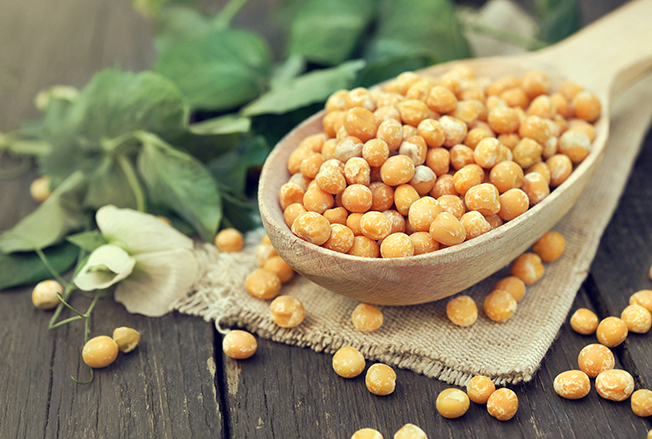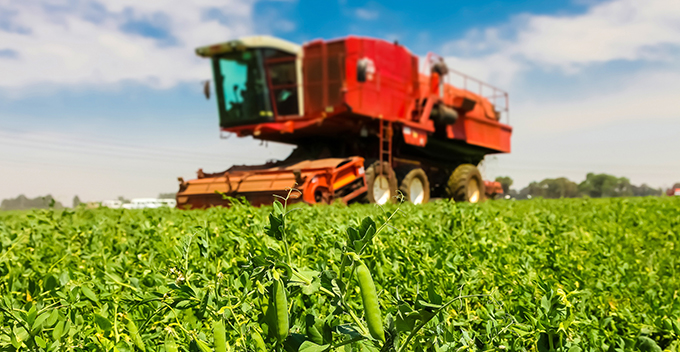

Interview: Michael Natale
Michael Natale, Ingredion’s Global Lead, Plant Based Protein Platform, explains why he is enthusiastic about the future, and reveals how his company is going to be right in the center of the innovations yet to come
Depending on what you read (and believe), the plant-based sector has either had its day or is set for more stupendous growth. What is undeniable, though, is consumers are now more conscious about their dietary choices and looking for healthier, sustainable and ethical plant-based products.
But if ever you’re feeling despondent about the way things are going – perhaps you’ve read one-too-many articles penned by the naysayers – just spend 30 minutes with Michael Natale, Global Lead of Ingredion’s Plant Based Protein Platform. Separating the hyperbole and hype from what is happening quite literally in the field, his enthusiasm and passion for the sector is such that it’s almost impossible to not be invigorated by what’s yet to come.

Natale has spent +20 years in the food ingredients industry, including 16 years at Bell Flavors & Fragrances, where he “gained valuable insights” and “deepened his understanding” of the “sensory aspects of taste”.
“Over the past three years, I’ve spearheaded our Plant Based Protein Platform, which we internally refer to as our ‘startup within a multinational company’,” Natale begins. “While the food industry has seen a surge in startups in this space, Ingredion has been diligently working on its own plant-based protein incubator for the past four to five years. We have formalized this initiative and invested more than US$250 million into our platform.”
Investing for the future
The majority of this investment centered around two key operations: one in Vanscoy, Saskatchewan, Canada, and a US facility in Sioux City, Nebraska. Of the Vanscoy operation, Natale explains, “Under the leadership of James and Suzy Cameron, Verdient Foods was pioneering innovative protein solutions using yellow pea, fava, chickpea, and lentil.
“In December 2020, we formed a JV with them before acquiring their operations. In 2021, we introduced new technology from the plant that allows us to produce proteins with minimal flavor impact from various pulse bases, which is crucial for enhancing the customer experience.”
Ingredion’s second big investment saw its Sioux City facility commissioned and launched in March 2021 to produce pea protein isolates (primarily for nutrition, health and wellness) with protein content exceeding +80%.
Natale suggests his division very much mirrors a startup in the way it operates day-to-day, through agility and speed to new product launches. “Over the past two and a half years, we’ve undertaken the commissioning of those two sites and successfully launched more than +30 products in numerous countries,” he continues.
Ingredion’s strategy revolves around three critical aspects: the flavor, functionality, and the nutrition of its proteins. “These three facets guide our day-to-day operations and the collaborative efforts with our R&D teams and customers worldwide,” Natale says. “In the startup world, it’s common knowledge that the path from point A to B is rarely a straightforward one. Instead, it’s characterized by constant adaptation and course correction. We navigate this dynamic journey through a series of zigzags, working closely with our suppliers, customers, and consumers to achieve success.”
We navigate this dynamic journey through a series of zigzags, working closely with our suppliers, customers, and consumers to achieve success
State of the union
So, what’s Natale’s inside opinion of the plant-based sector currently? “We place a strong emphasis on data analysis and closely monitor consumer trends,” he responds. “Over the past five years, we’ve witnessed remarkable growth, with some estimates valuing it at more than US$8 billion. This translates to a CAGR of approximately 12-13%. Our initial expectations were for a growth rate exceeding 10% CAGR a year, and it’s currently stabilizing at around 6-8%, which is still highly promising in food and beverage sectors.”
And at the consumer’s table, research conducted over the past two years reveals that more than 50% of households have been embracing plant-based protein offerings.

However, even those in the industry accept that not all products are created equal, and some have not lived up to expectations. “That’s what motivates us to double down in developing third- and fourth-generation products to enhance the experience, especially for flexitarians who seek a complete package in terms of flavor, functionality, and nutrition.”
Natale has witnessed two trends that bear resemblance to the plant-based protein movement. “The first was organic food,” he says. “Some major players initially made grand promises and had ambitious plans for organics that didn’t fully materialize. Nevertheless, organic products have consistently grown in popularity.”
The second trend was the emergence of energy beverages in Europe. “Initially, they served a niche market, but they experienced remarkable growth and now command a market valued at several billion dollars,” Natale says.
Drawing parallels, the plant-based protein sector has seen a big focus on alternative meat products, although Natale we should recognize its impact extends outside of burgers, nuggets and sausages. “Alternative dairy, snacking, and bakery have all experienced tremendous growth, with snacking poised to continue its expansion.”
Sports nutrition
Another key market for Ingredion that is seeing an upward trend is sports nutrition. “It’s not limited to professional athletes but has become accessible and appealing to a broader range of consumers focused on health, wellness, and performance, whether that’s in sports or in everyday life,” Natale says. And the diversity of sports nutrition products extends beyond traditional supplements: bars, snacks, and even meal replacements. “This array of options allows consumers to tailor their nutrition to their needs, whether it’s pre- or post-workout recovery, muscle building, weight management, or general health and wellness.”
For sports nutrition applications, Ingredion offers a pea and rice protein isolate blend that boasts a PDCAAS score of 1 .0. The company’s blend even allows customers to make on-pack protein claims that consumers seek when making their purchasing decisions.
“A PDCAAS score of 1 .0 indicates the protein source provides an excellent quality of protein with high digestibility and amino acid profile, making it an ideal choice for sports nutrition and other applications where protein quality is crucial,” Natale confirms. “Digestibility is a key factor in the effectiveness of protein supplements, especially in sports nutrition, where rapid and efficient protein absorption is essential for muscle recovery and growth.”

Overall, across all segments, Natale believes there to be a strong and consistent demand for fortified protein in consumer products. “It has emerged as a significant marketing driver, with consumers seeking protein options that offer various benefits, such as being allergen-free, providing essential macronutrients, promoting animal wellness, supporting sustainability and regenerative agriculture, and being affordable without compromising on quality or taste. The majority of consumers – approximately 80% – prioritize a good taste experience when choosing protein products. This taste factor is crucial.”
Consumers also recognize the importance of protein in their diets and are willing to pay more for the right protein sources. Marketers in CPG companies understand the appeal of protein fortification, especially in bars, snacks, bakery items, and dairy alternatives. These products attract a lot of attention and, importantly, drive repeat purchases.
“Ultimately, I anticipate a consistent growth trajectory of around 6-8% over the next five years in the fortified protein market,” Natale predicts. “However, there’s potential for even higher growth rates, especially in categories where novel innovations create unique and enjoyable experiences for consumers. The ingredients we have at our disposal offer substantial value propositions, and we are genuinely excited about the future of this industry.”
Turning the topic to the notion that plant-based foods are ‘overprocessed’, Natale counters that by declaring that clean-label ingredients have been a significant focus for Ingredion. According to its proprietary ATLAS research, ‘Natural’ claims are important to ~70% of consumers from 18-74 years of age in alternative dairy, whereas in meat alternatives it is more important for younger consumers (78% of 18-34 year-olds) versus older consumers (68% for 50-74 year-olds).
“We aim to formulate with ingredients that consumers recognize and feel comfortable with,” Natale says. “This may involve reducing the ingredient list to just a few recognizable ingredients. Our goal is to create nutritious products that align with consumers’ daily nutritional needs.”
The ingredients we have at our disposal offer substantial value propositions, and we are genuinely excited about the future of this industry
Lowering sodium content in its proteins and other ingredients has also been a key initiative for Ingredion over the past few years. “We’ve made substantial progress in this area,” he says. “However, it’s important to view these efforts in the context of processed foods generally. Whether it’s a plant-based chicken nugget or a traditional chicken nugget, some level of processing is involved in both.”
Planetary goals?
Another reason to embrace plant-based foods is the environment. As backed up by research, consuming less meat and dairy can have huge benefits for the planet. Around 119m2 of land is required to generate 1,000 kilocalories from a herd of beef cattle. The same amount of calories from cow’s milk takes up almost 15m2. If you compare that to rice – a staple for much of the world – it requires less than 1m2 of land for a yield of 1,000 kilocalories.
“In today’s landscape, consumers are increasingly aware of the environmental impact of their choices, and they’re actively seeking products and brands that align with their values,” believes Natale. However, he stresses sustainability alone is not sufficient. “While a sustainable product may attract initial interest and support, its long-term success hinges on its ability to deliver a positive overall experience.”
Plant-based proteins often excel in terms of efficiency, as they typically require fewer resources such as water and land. This not only aligns with environmental sustainability but will also eventually contribute to affordability – a key factor for many consumers. “It’s more than a buzzword,” Natale points out. “Sustainability is a guiding principle that informs product development and also how brands interact with and resonate with consumers.”
Ultimately, sustainability at Ingredion means action rather than words. A criticism levied against CPGs when it comes to improving their sustainability is that it’s hard to measure the progress they make. On that, Ingredion works with a third-party technology group called HowGood, the world’s largest product sustainability database.
“By evaluating factors such as water usage, energy consumption, and carbon emissions on a per-ingredient basis, we can pinpoint areas for improvement and work toward greater sustainability,” Natale explains. “This not only benefits the environment but can also lead to cost savings and more efficient resource use. Moreover, by offering this information to consumer product companies, you enable them to make more sustainable product choices, which, in turn, aligns with the increasing consumer demand for eco-friendly and socially responsible products.”

Natale entered the field, in his own words, with “the goal of addressing global food security”, a mission that deeply motivates him. “I firmly believe that plant-based proteins are perfectly aligned with this objective,” he says. “Currently, yellow peas are primarily used as cattle feed before eventually reaching our plates. We truly believe harnessing the power of yellow peas and other pulses serves the food chain in a very efficient manner going forward.”
Ultimately, though, it all circles back to the core idea of nourishing the world. Natale says it’s important to note that there’s no single solution to the complex landscape of food ingredients, which is influenced by diverse cultures and specific needs. Plant-based ingredients, he argues, offer a multitude of advantages, providing sustainable options for Ingredion’s customers which, in turn, develop products to help feed the world.
“My aspiration is for this movement to sustain its impressive growth rate and to maintain its edgy, creative, and entrepreneurial origins,” Natale concludes. “If it continues along this path, I am confident it will achieve success.”
If you have any questions or would like to get in touch with us, please email info@futureofproteinproduction.com







